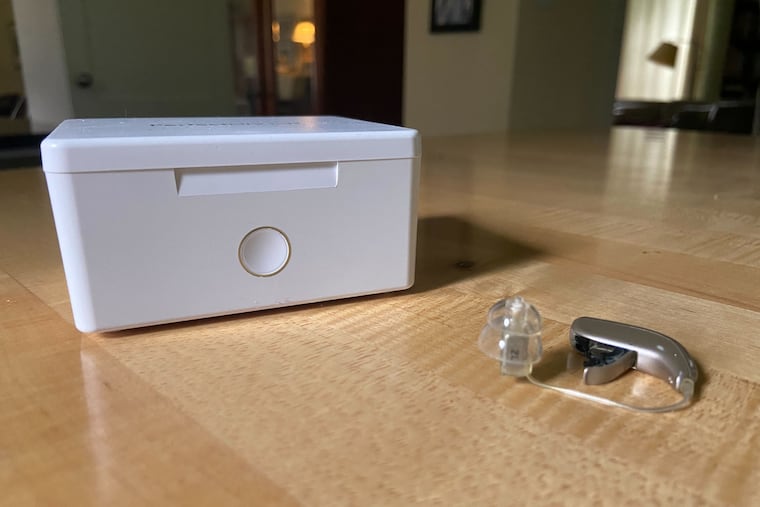4 tips to protect your hearing aid in the muggy months of summer
Heat and humidity can affect sound quality, especially in older models of hearing aids.

Every summer, hearing-aid wearers come to audiologist Rebecca Blaha with the same complaint. Suddenly, their sound quality has become muffled or crackly. In some cases, her patients at the Pennsylvania Ear Institute can no longer hear anything.
Invariably, the culprit is moisture.
In places with year-round warmth, such as Florida, hearing-aid wearers may have a better idea of how to keep their devices working in the heat and humidity. But in Pennsylvania, New Jersey, and other northern states, plenty of customers are caught off guard each year, said Blaha, an assistant professor at Salus University in Elkins Park.
Other northerners are aware of the summertime risks of moisture, but they overreact — opting to leave the devices behind when headed to the Jersey Shore, Blaha said. Not a great idea.
“They think they have to sacrifice some of their hearing to have a good time,” she said. “But we want you to try to wear your hearing aids as often as possible.”
Here’s how to keep the devices in tip-top shape, even on days when the air feels like soup.
» READ MORE: Hearing aids will now be available without a hearing test. Here's the story on the new 'over-the-counter' devices.
Use a hearing-aid drier
Hearing aids are designed to work in the heat and humidity, but many models, especially the older ones, can handle only so much.
It’s a good idea to invest in some type of drying device, Blaha said.
Among the options are simple canisters with desiccant beads, which absorb moisture. They are fairly inexpensive and great for travel.
Other driers are electric, removing moisture from the hearing aid with a combination of heat and a desiccant “brick.” Still others rely on heat alone.
» READ MORE: This summer, watch for these signs of dehydration and heat exhaustion, especially in older people
The prices of driers vary widely — some models are as much as $100 — so check with your audiologist or hearing-aid dealer for a recommendation. Better to spend a bit of money on prevention, as the hearing aid itself is far pricier, typically costing more than $2,000. And as users well know, hearing aids often are not covered by insurance.
Be sure to follow manufacturer instructions, as some older driers may be too warm for the newer rechargeable hearing aids (more on those below). Instead, some rechargeable aids have driers incorporated into their charging devices.
Change the wax guard
Many hearing aids contain a small, replaceable filter to protect the device’s electronic components from ear wax.
Technically called cerumen, this substance may clog up the filter more often in higher temperatures, Blaha said. The filter also can become saturated with moisture.
In either case, sound quality will suffer. Try changing the filter, or if you have trouble (they’re tiny!), ask your audiologist or hearing-aid dealer to give you a hand.
A tip on ear wax
Blow it out
Some older behind-the-ear hearing aids deliver the sound into the ear canal through a clear plastic tube.
During hot, sticky months, beads of moisture can condense inside the tube.
“It will start to look a little like a greenhouse,” Blaha said.
If so, remove the tube as directed, and expel the moisture with a manual, hand-held blower (a rubber bulb with nozzle). But as with the wax filter, get professional help if needed.
For those with recurrent problems, Blaha sometimes swaps out the plastic tube for a temporary “dry tube,” which is sprayed with a moisture-resistant coating. Still others swaddle their hearing aids in sleeves made from moisture-wicking fabric.
“They look like little socks,” Blaha said.
Time for an upgrade?
Most older hearing aids are powered by zinc batteries, which are activated by the surrounding air. Because they need to admit air, such devices also are vulnerable to moisture.
Newer rechargeable hearing aids are powered by lithium-ion batteries, which do not require air to activate and thus can be more tightly sealed against moisture intrusion. (The same battery technology is used in most cell phones and laptops.)
If you are due for a new hearing aid, consider going rechargeable. Rechargeable batteries cost more up front, but may be easier to use and less expensive in the long run, according to the nonprofit Hearing Loss Association of America.
But no matter what the device, take extra care in the summer to keep it dry. Your hearing aid will last longer — and your friends and family will thank you.